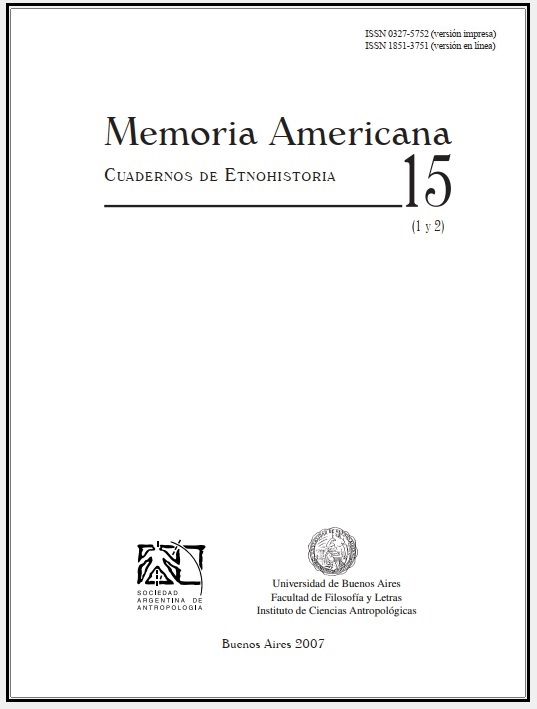Death and burial places: the southern Andean region, Salta 18th Century
Abstract
Burials not only reflect the legal, social and ethnic status of individuals, they also show a network of social relationships among which we find signs of exclusion, subjection and personal and collective links. The complexity of burial places cannot be understood without considering peoples’ imaginary about death. We will focus specifically on spaces thought of as burial grounds on Salta city during the eighteenth Century in order to recognize “places” full of meaning to their inhabitants. The concept of place refers to the real and symbolic construction of space and Historians, without falling in an ethnographic illusion of transparency, are able to search for social markers and signs of identity, hierarchy and stratification as well as some clues regarding different imaginaries which give value and sustain those burial places in the town’s center.Downloads
References
Aries, Philippe 2000. Historia de la muerte en Occidente. Desde la Edad Media a nuestros días. Barcelona, El Acantilado.
Augé Marc 1996. Hacia una antropología de los mundos contemporáneos, Barcelona, GEDISA.
Augé Marc 2000. Los no lugares. Espacios del anonimato. Barcelona, GEDISA.
Baczko, Bronislaw 1991. Los imaginarios sociales. Memorias y esperanzas colectivas. Buenos Aires, Nueva Visión.
Bourdieu Pierre 1998. El conocimiento por cuerpos. En Bourdieu, P.; Meditaciones Pascalianas. Madrid, Anagrama.
Caretta, Gabriela A. e Isabel E. Zacca 2004. La muerte en el imaginario colonial. Un análisis de los enterratorios en Salta a fines de la colonia. I Jornada de Estudios sobre Religiosidad Cultura y Poder. Buenos Aires, GERE.
Caretta, Gabriela A. e Isabel E. Zacca 2006. La muerte y sus indicios. Salta: ciudad y frontera en 1730. Revista de Estudios Religiosos 1. México, en prensa.
Caretta, Gabriela A. e Isabel E. Zacca 2007. Enterrar de gracia: Notas en la construcción de identidades sociales en Salta en tiempos de cambio (1730-1830). Ponencia inédita presentada en Primeras Jornadas Nacionales de Historia Social. La Falda (Córdoba).
Casalino Sen, Carlota 1999. Higiene pública y piedad ilustrada: la cultura de la muerte bajo los borbones. En O’Phelan Godoy, S. (comp.); El Perú en el siglo XVIII. La era borbónica. Lima, Pontificia Universidad Católica del Perú / Instituto Riva Agüero.
Cornejo Polar, Antonio 1998. Mestizaje e hibridez: los riesgos de las metáforas. Revista de crítica literaria latinoamericana 47. Hanover (USA).
Corral Bustos, Adriana y David Vázquez Salguero 2003. El cementerio del Saucito en San Luis Potosí. Relaciones 94. México, El Colegio de Michoacán.
Delumeau, Jean 1972. Demographie et mentalités: La mort en Anjou (XVII-XVIII siècle). Annales 27 (6): 1389-1399. Versión on line en www.persee.fr
Di Stefano, Roberto y Loris Zanatta 2000. Historia de la Iglesia Argentina. Desde fines de la Conquista hasta fines del siglo XX. Buenos Aires, Mondadori.
Ferreiro, Juan Pablo 1999. Temporalia et aeterna. Apuntes sobre la muerte barroca en el Jujuy colonial del siglo XVII. Andes 10: 113-138. Salta, CEPIHA-UNSa.
Frías, Bernardo 1913. Tradiciones históricas. Salta, s/e.
Ginzburg, Carlo 2004. Huellas. Raíces de un paradigma indiciario. Intervención sobre el paradigma indiciario. En Ginzburg, C.; Tentativas. Rosario, Prohistoria.
Glave, Luis Miguel 1989. Trajinantes. Caminos indígenas en la sociedad colonial. Lima, Instituto de Apoyo Agrario.
Gruzinski, Serge 1999. Las imágenes, los imaginarios y la occidentalización. En Carmagnani, M. y otros; Para una Historia de America I, Las estructuras. México, FCE.
Lebrun, François 1980. Les crises démographiques en France aux XVII et XVIII siècles. Annales (E.S.C.) 35 (2): 205-234. París.
Lomnitz, Claudio 2006. Idea de la muerte en México. México, FCE.
Meuvret, Jean 1971. Les crises de subsistence et la démographie de la france d´ancien régime. Etude d´histoire economique. Cahiers des annales 32. París.
Peirano, Mariza 2001. Rituais como estratégia analítica e abordagem etnográfica. Série Antropología 305. Brasilia, Universidade do Brasilia.
Peire, Jaime 2000. El taller de los espejos. Buenos Aires, Claridad.
Pintos, José Luis 2001. Apuntes para un concepto operativo de imaginarios sociales. En Alburquerque, L. y R. Iglesias (comps.); Sobre imaginarios urbanos: 67-103. Buenos Aires, FADUBA.
Punta, Ana Inés 1997. Córdoba borbónica. Persistencias coloniales en tiempo de reformas (1750-1800). Córdoba, Universidad Nacional de Córdoba.
Taylor, William 1999. Ministros de lo sagrado. Sacerdotes y feligreses en el México del siglo XVIII I. México, El Colegio de México / El Colegio de Michoacán / Secretaría de Gobernación.
Toscano, Julián 1907. El primitivo Obispado del Tucumán y la Iglesia de Salta. Buenos Aires, Imprenta de Biedma.
Vovelle, Michelle 2002. Historia de la muerte. Cuadernos de Historia 22. Santiago de Chile, Departamento de Ciencias Históricas, Facultad de Filosofía y Humanidades, Universidad de Chile.
Will de Chaparro, Martina 2003. De cuerpo a cadáver. El tratamiento de los difuntos en Nueva México
en los siglos XVIII y XIX. Relaciones 94: 59-90. México, El Colegio de Michoacán.
Zacca, Isabel 1997. Matrimonio y mestizaje entre los indios, negros, mestizos y afromestizos en la ciudad de Salta (1766-1800). Andes 8: 243-269. Salta, CEPIHA-UNSa.
Zárate Toscazo, Verónica 2000. Los nobles ante la muerte en México. Actitudes, ceremonias y memorias (1750-1850). México, El Colegio de México/Instituto Mora.
Copyright (c) 2007 Memoria Americana. Cuadernos de Etnohistoria

This work is licensed under a Creative Commons Attribution-NonCommercial-ShareAlike 4.0 International License.
Los derechos de autor son cedidos a Memoria Americana. Cuadernos de Etnohistoria, no obstante los autores podrán recuperarlos y reproducir su trabajo en otros medios o formatos previo envío de solicitud al Comité Editorial. En tales casos, deberá citarse a Memoria Americana. Cuadernos de Etnohistoria como primera publicación del trabajo y el mismo queda bajo una licencia Creative Commons CC BY NC SA 3.0 Attribution- Non Commercial -ShareAlike 3.0, la cual provee libre acceso inmediato a sus contenidos pues se rige por el principio según el cual hacer disponible -en forma gratuita- la investigación al público fomenta un mayor intercambio de conocimiento a nivel global.
Los autores deberán remitir el siguiente formulario de cesión de derechos y compromiso de originalidad:
Cesión de derechos y compromiso de originalidad
Al Comité Editorial de Memoria Americana, Cuadernos de Etnohistoria
Por la presente declaro ser el autor del trabajo titulado (nombre del artículo), el mismo es original y propio y no ha sido publicado en ningún formato o soporte con anterioridad.
En caso de ser aceptado para su publicación en Memoria Americana. Cuadernos de Etnohistoria (número/año) cedo los derechos editoriales que me corresponden por el aludido artículo para su publicación en todos los formatos que posea la mencionada revista.
Si quisiera publicar este artículo a través de otro editor o en otro lugar me comprometo a solicitar el correspondiente permiso por escrito al Comité Editorial de Memoria Americana. Cuadernos de Etnohistoria. De ser afirmativa la respuesta del Comité Editorial me comprometo a lo siguiente:
- especificar lugar, editorial y fecha de la primera publicación del artículo en la nueva publicación
- realizar esta republicación sólo luego de transcurridos un año calendario desde la fecha de la presente nota de cesión de derechos
FIRMA
Aclaración











